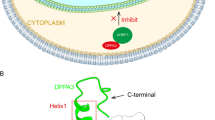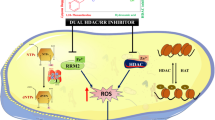Abstract
The complexing of histones with DNA and the resulting condensation of chromatin protects mammalian cell, from radiation-induced strand breakage. In the present study, benzimidazoles DMA and TBZ showed marked radioprotection through drug-induced compaction of chromatin and direct quenching of free radicals generated by radiation. The mammalian cells were incubated with 100 μM concentration of DMA and TBZ and irradiated at 5 Gy; both the ligands showed nuclei condensation suggesting a probable mechanism to protect DNA from radiation damage. The bisubstituted analogs of Hoechst 33342 are found to be better free radical scavengers and protect DNA against radiation-induced damage at a lower concentration than the parent molecule. Both the ligands also quenched free radicals in isolated free radical system suggesting their dual mode of action against radiation-induced damage to DNA. Molecules binding to the chromatin alter gene expression, whereas in this study both the ligands have not shown any profound effect on the nucleosome assembly and gene expression in vitro and in vivo. Both ligands afford a 2-fold protection by altering DNA structure as well as through direct free radical quenching in bulk solution in comparison to the parent ligand, which acts only through quenching of free radicals.






Similar content being viewed by others
Abbreviations
- DMA:
-
5-(4-Methylpiperazin-1-yl)-2-[2′-(3,4-dimethoxyphenyl)-5′-benzimidazolyl] benzimidazole
- TBZ:
-
5-(4-Methylpiperazin-1-yl)-2-[2′{2′′-(4-hydroxy-3-methoxyphenyl)-5′′-benzimidazolyl}-5′-benzimidazolyl] benzimidazole
- EPR spectroscopy:
-
Electron paramagnetic resonance spectroscopy
- ROS:
-
Reactive oxygen species
- LET:
-
Linear energy transfer
- TEMPO:
-
2,2,6,6-Tetramethylpiperidine-1-oxyl
References
Chiu S, Oleinick NL (1996) Radioprotection against the formation of DNA double-strand breaks in cellular DNA but not native cellular chromatin by the polyamine spermine. Radiat Res 148:188–192
Douki T, Bretonniere Y, Cadet J (2000) Protection against radiation-induced degradation of DNA bases by polyamines. Radiat Res 153:29–35
Chiu S, Oleinick NL (1996) Radioprotection of cellular chromatin by the polyamines spermine and putrescine: preferential action against formation of DNA–protein crosslink. Radiat Res 149:543–549
Warters RL, Newton GL, Olive PL et al (1999) Radioprotection of human cell nuclear DNA by polyamines: radio sensitivity of chromatin is influenced by tightly bound spermine. Radiat Res 151:354–362
Hall EJ (2000) Radiobiology for the radiobiologist, 5th edn. Lippincott Williams & Wilkins, Philadelphia
von, Sonntag C (1987) The chemistry of free radical mediated DNA damage. Physical and Chemical mechanism in Mol Rad Biol 287–310
Devasagayam TPA, Subramanian M, Singh BB et al (1995) Protection of plasmid pBR322 DNA by flavonoids against single-strand breaks induced by singlet molecular oxygen. J Photochem Photobiol B: Biol 30:97–103
Kim GJ, Fiskum GM, Morgan WF (2006) A role for mitochondrial dysfunction in perpetuating radiation-induced genomic instability. Cancer Res 66:10377–10383
Wolffe AP (1994) Nucleosome positioning and modification: chromatin structures that potentiate transcription. Trends Biochem Sci 19:240–244
Pruss DJ, Hayes J, Wolffe AP (1995) Nucleosomal anatomy—where are the histones? Bioessays 17:161–170
Beato M, Eisfeld K (1997) Transcription factor access to chromatin. Nucleic Acids Res 25:3559–3563
Pennings S, Meersseman G, Bradbury FM (1992) Effect of glycerol on the separation of nucleosomes and bent DNA in low ionic strength polyacrylamide gel electrophoresis. Nucleic Acids Res 20:6667–6672
Gruss C, Wu J, Koller T, Sogo JM (1993) Disruption of the nucleosomes at the replication fork. EMBO J 12:4533–4545
Adams C, Workman J (1993) Nucleosome displacement in transcription. Cell 72:305–308
Pazin MJ, Bhargava EP, Geiduschek EP et al (1997) Nucleosome mobility and the maintenance of nucleosome positioning. Science 276:809–812
Cairns MJ, Murray V (1996) Influence of chromatin structure on bleomycin–DNA interactions at base pair resolution in the human β-Globin gene cluster. Biochemistry 35:8753–8760
Enright H, Miller WJ, Hays R et al (1996) Preferential targeting of oxidative base damage to internucleosomal DNA. Carcinogenesis 17:1175–1177
Zimmer C, Wahnert U (1986) Nonintercalating DNA-binding ligands: specificity of the interaction and their use as tools in biophysical, biochemical and biological investigations of the genetic material. Prog Biophys Mol Biol 47:31–112
Geierstanger BH, Wemmer DE (1995) Complexes of the minor groove of DNA. Annu Rev Biophys Biomol Struct 24:463–493
Eriksson S, Kim SK, Kubista M et al (1993) Binding of 4′,6-diamidino-2-phenylindole (DAPI) to AT regions of DNA: evidence for an allosteric conformational change. Biochemistry 32:2987–2998
Kas E, Poljak L, Adachi Y et al (1993) A model for chromatin opening: stimulation of topoisomerase II and restriction enzyme cleavage of chromatin by distamycin. EMBO J 12:115–126
Sen D, Crothers DM (1986) Influence of DNA–binding drugs on chromatin condensation. Biochemistry 25:1503–1509
Radic MZ, Lundgren K, Hamkalo BA (1987) Hoechst 33258, distamycin A, and high mobility group protein I (HMG-I) compete for binding to mouse satellite DNA. Cell 50:1101–1108
Low CM, Drew HR, Waring MJ (1986) Echinomycin and distamycin induce rotation of nucleosome core DNA. Nucleic Acids Res 14:6785–6801
Perez JJ, Portugal J (1980) Molecular modelling study of changes induced by netropsin binding to nucleosome core particles. Nucleic Acids Res 18:3731–3737
Denison L, Haigh A, D’Cunha GM et al (1992) DNA ligands as radioprotectors: molecular studies with Hoechst 33342 and Hoechst 33258. Int J Radiat Biol 61:69–81
Lyubimova NV, Coultas PG, Yuen K et al (2001) In vivo radioprotection of mouse brain endothelial cells by Hoechst 33342. Br J Radiol 74:77–82
Singh SP, Jayanth VR, Chandna S et al (1998) Radioprotective effects of DNA ligands Hoechst 33342 and 33258 in whole body irradiated mice. Ind J Exp Biol 36:375–384
Loontiens FG, Regenfuss P, Zechel A et al (1990) Binding characteristics of Hoechst 33258 with calf thymus DNA, poly[d(A-T)], and d(CCGGAATTCCGG): multiple stoichiometries and determination of tight binding with a wide spectrum of site affinities. Biochemistry 29:9029–9039
Martin RF, Anderson RF (1998) Pulse radiolysis studies indicate that electron transfer is involved in radioprotection by Hoechst 33342 and methylprolamine. Int J Radiat Oncol Biol Phys 42:827–831
Adhikary A, Bothe E, Jain V et al (2000) Pulse radiolysis of the DNA-binding bisbenzimidazole derivatives Hoechst 33258 and 33342 in aqueous solutions. Int J Radiat Biol 76:1157–1166
Tawar U, Jain AK, Dwarakanath BS et al (2003) Influence of phenyl ring disubstitution on bisbenzimidazole and terbenzimidazole cytotoxicity: synthesis and biological evaluation as radioprotectors. J Med Chem 46:3785–3792
Tawar U, Jain AK, Chandra R et al (2003) Minor groove binding DNA ligands with expanded A/T sequence length recognition, selective binding to bent DNA regions and enhanced fluorescent properties. Biochemistry 42:13339–13346
Ha HC, Sirisoma NS, Kuppusamy P et al (1998) The natural polyamine spermine functions directly as a free radical scavenger. Proc Natl Acad Sci USA 95:11140–11145
Pulley DE, Ellison MJ (1982) Purification and properties of type I topoisomerase from chicken erythrocytes: mechanism of eukaryotic topoisomerase action. Biochemistry 21:1155–1161
Drew HR, Travers AA (1985) DNA bending and its relation to nucleosome positioning. J Mol Biol 186:773–790
Shrader T, Crothers D (1990) Effects of DNA sequence and histone–histone interactions on nucleosome placement. J Mol Biol 216:69–84
Dhawan A, Bajpayee M, Pandey AK et al Protocol for the single cell gel electrophoresis/comet assay for rapid genotoxicity assessment. ITRC: the SCGE/comet assay protocol
Chandna S (2004) Single-cell gel electrophoresis assay monitors precise kinetics of DNA fragmentation induced during programmed cell death. Cytometry 61A:127–133
Maron DM, Ames BN (1983) Revised methods for the Salmonella mutagenicity test. Mutation Res 113:173–215
Ames BN, Mccann J, Yamasaki E (1975) Methods for detecting carcinogens and mutagens with the salmonella/mammalian-microsome mutagenicity test. Mutation Res 31:347–364
Dwarakanath BS, Khaitan D, Ravindranath T (2004) 2-deoxy-d-glucose enhances the cytotoxicity of topoisomerase inhibitors in human tumor cell lines. Cancer Biol Ther 3:864–870
Duand RE, Olive PL (1982) Cytotoxicity, mutagenicity and DNA damage by Hoechst 33342. J Histochem Cytochem 30:111–116
Brown PM, Fox KR (1996) Minor groove binding ligands alter the rotational positioning of DNA fragments on nucleosome core particles. J Mol Biol 262:671–685
Fitzgerald DJ, Anderson JN (1999) Selective nucleosome disruption by drugs that bind in the minor groove of DNA. J Biol Chem 274:27128–27138
Portugal J, Waring MJ (1987) Analysis of the effects of antibiotics on the structure of nucleosome core particles determined by DNase I cleavage. Biochimie 69:825–840
Valota A, Ballarini F, Friedland W et al (2003) Modelling study on the protective role of OH radical scavengers and DNA higher-order structures in induction of single- and double-strand break by gamma-radiation. Int J Radiat Biol 79:643–653
Nygren J, Ljungman M, Ahnstrom G (1995) Chromatin structure and radiation-induced DNA strand breaks in human cells: soluble scavengers and DNA-bound proteins offer a better protection against single-than double-strand breaks. Int J Radiat Biol 68:11–18
Swenberg CE, Speicher JM (1995) Neutron and gamma-radiation sensitivity of plasmid DNA of varying superhelical density. Radiat Res 144:301–309
Cheong N, Perrault AR, Illiakis G (1998) In vitro rejoining of DNA double strand breaks: a comparison of genomic-DNA with plasmid-DNA-based assays. Int J Radiat Biol 73:481–491
Lapchak PA, Chapman DF, Zivin JA (2001) Pharmacological effects of the spin trap agents N-t-Butyl-Phenylnitrone (PBN) and 2,2,6,6,-Tetramethylpiperidine-N-Oxyl (TEMPO) in a rabbit thromboembolic stroke model: combination studies with the thrombolytic tissue plasminogen activator. Stroke 32:147–153
Yokoya A, Watanbe R, Hara T (1999) Single- and double-strand breaks in solid pBR322 DNA induced by ultrasoft X-rays at photon energies of 388, 435 and 573 eV. J Radiat Res 40:145–158
Britigan BE, Coffman TJ, Buettner GR (1990) Spin trapping evidence for the lack of significant hydroxyl radical production during the respiration burst of human phagocytes using a spin adduct resistant to super oxide-mediated destruction. J Biol Chem 265:2650–2656
Samuni A, Goldstein S, Russo A et al (2002) Kinetics and mechanism of hydroxyl radical and OH-Adduct radical reactions with nitroxides and with their hydroxylamines. J Am Chem Soc 124:8719–8724
Mohan H, Adhikary A, Jain V et al (2000) Quenching of nucleotide derived radicals by bisbenzimidazole derivative Hoechst-33258 in aqueous solution. Proc Indian Acad Sci (Chem Sci) 112:487–496
Adhikary A, Bothe E, Jain V et al (1997) Inhibition of radiation-induced DNA strand breaks by Hoechst 33258: OH-radical scavenging and DNA radical quenching. Radioprotection 32:C1-89–C1-90
Adhikary A, Bothe E, von Sonntag C et al (1997) DNA radioprotection by bisbenzimidazole derivative Hoechst 33258: model studies on the nucleotide level. Radiat Res 148:493–494
Low CM, Drew HR, Waring MJ (1986) Echinomycin and distamycin induce rotation of nucleosome core DNA. Nucleic Acids Res 14:785–680
Leslie KD, Fox KR (2002) Interaction of Hoechst 33258 and echinomycin with nucleosomal DNA fragments containing isolated ligand binding sites. Biochemistry 41:3484–3497
Acknowledgments
One of the authors Urmila Tawar is indebted to Council of Scientific and Industrial Research, New Delhi for financial assistance as Senior Research Fellowship. Authors would like to thank Dr. Dwarakanath at Institute of nuclear medicine and allied sciences for providing radiation source.
Author information
Authors and Affiliations
Corresponding author
Electronic supplementary material
Below is the link to the electronic supplementary material
Rights and permissions
About this article
Cite this article
Tawar, U., Bansal, S., Shrimal, S. et al. Nuclear condensation and free radical scavenging: a dual mechanism of bisbenzimidazoles to modulate radiation damage to DNA. Mol Cell Biochem 305, 221–233 (2007). https://doi.org/10.1007/s11010-007-9546-y
Received:
Accepted:
Published:
Issue Date:
DOI: https://doi.org/10.1007/s11010-007-9546-y




